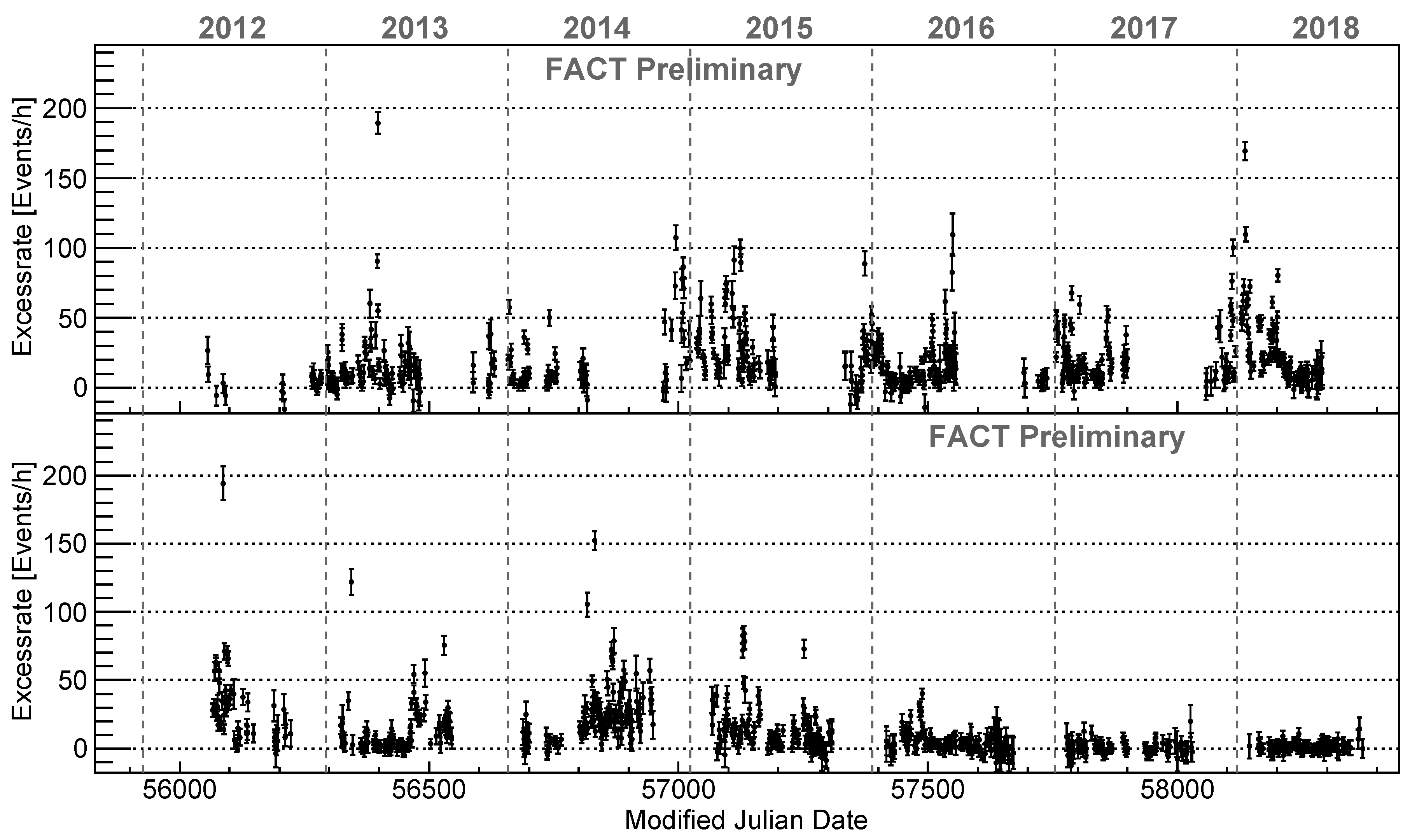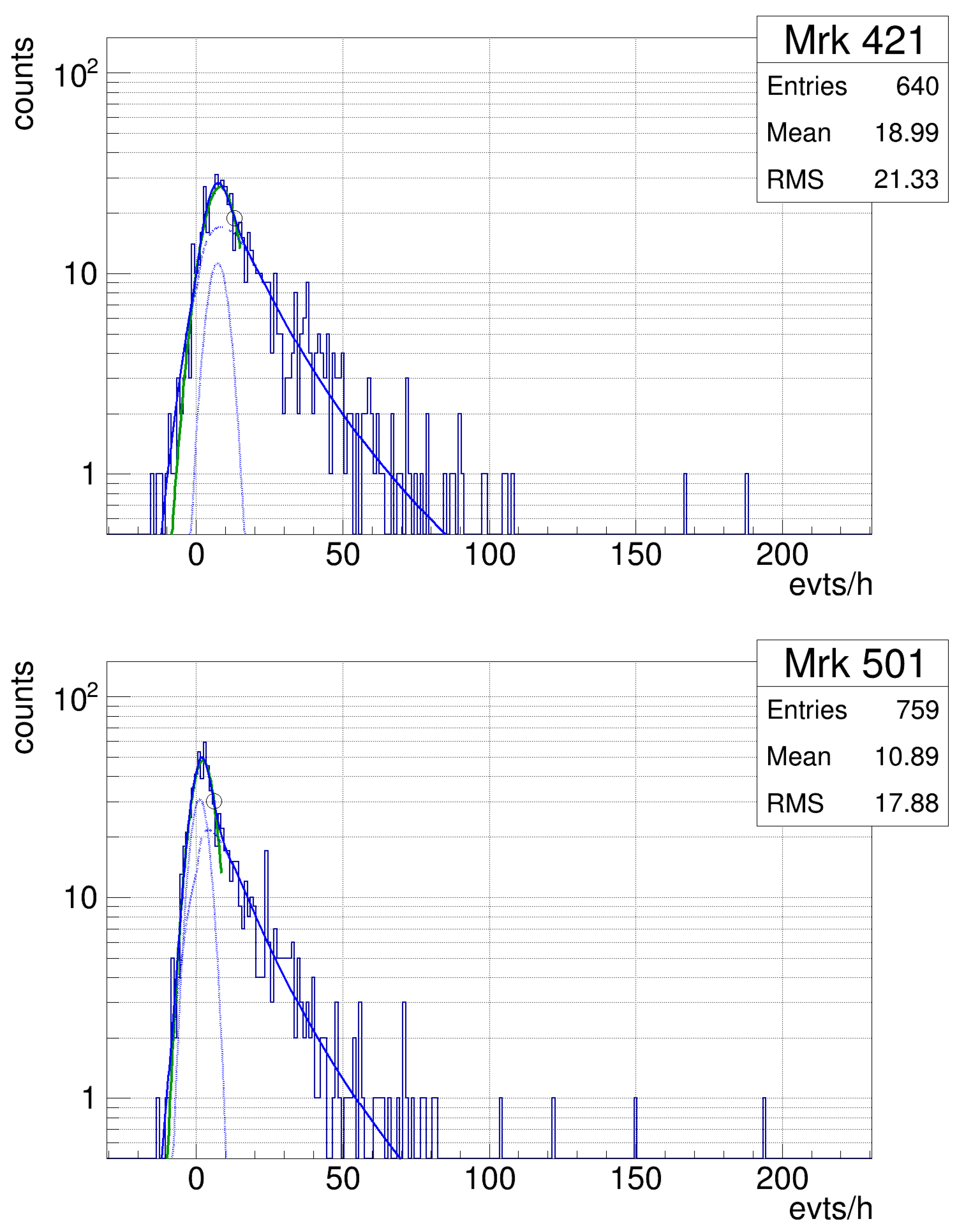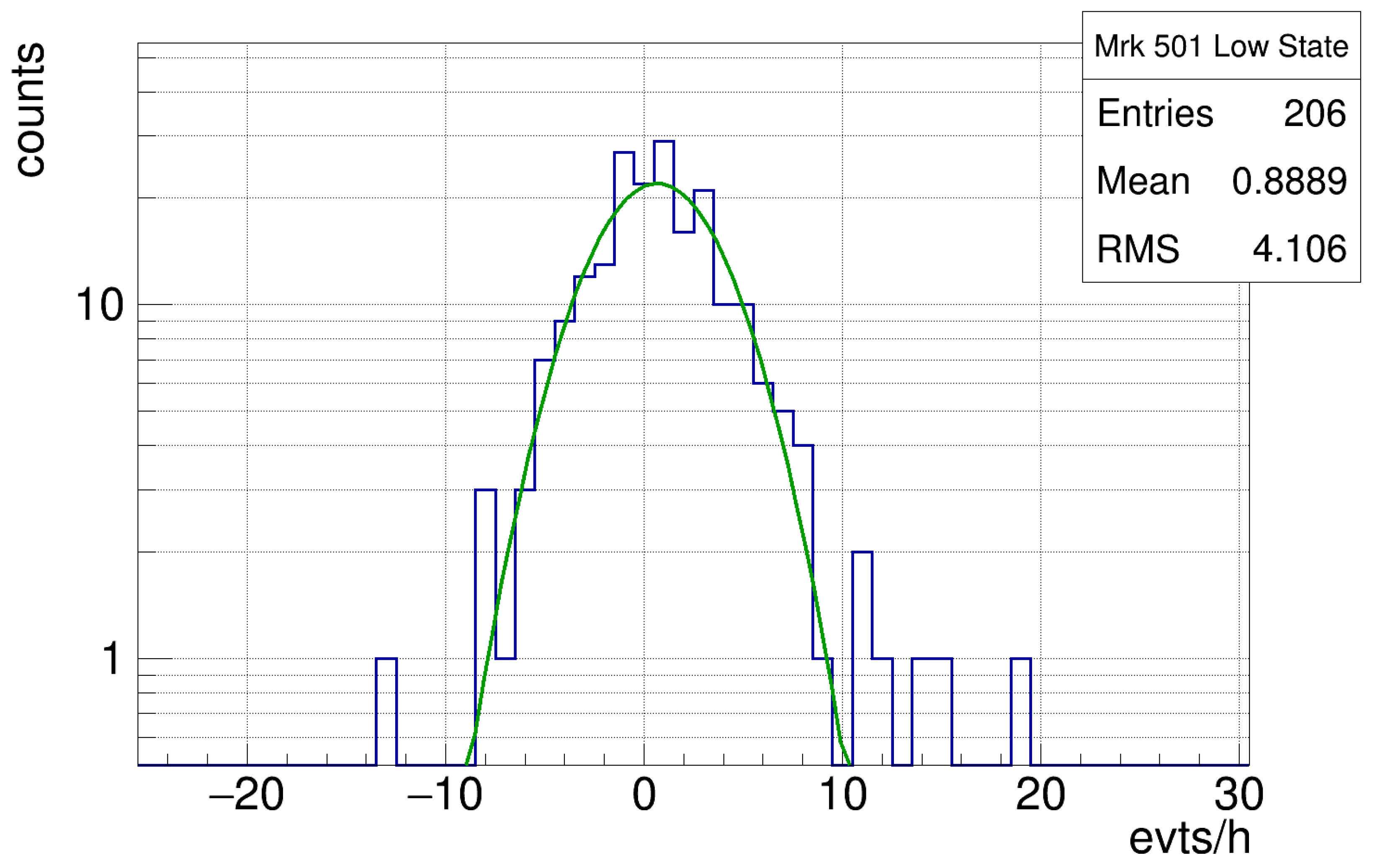Flux States of Active Galactic Nuclei
Abstract
1. Introduction
1.1. Blazars
1.2. Multi-Wavelength Observations
1.3. Multi-Messenger Context
1.4. FACT—Monitoring the TeV Sky
2. Flux States
2.1. Shape of Flux Distribution
2.2. Steady State Emission
2.3. Duty Cycle
2.4. Definition of Threshold
2.5. Long-Term Monitoring
3. Data Sample from FACT Long-Term Monitoring
3.1. Sources
3.2. Analysis and Data Selection
3.3. Determining the Steady State
3.4. Threshold for Flaring States
4. Results
4.1. Mrk 421
4.2. Mrk 501
5. Multi-Messenger Context
5.1. Flux above Steady State
5.2. Trigger Threshold with Respect to Mean Flux
6. Summary and Outlook
6.1. Steady State Flux
6.2. Triggers to MWL and MM Instruments
Author Contributions
Funding
Acknowledgments
Conflicts of Interest
References
- Böttcher, M. Progress in Multi-wavelength and Multi-Messenger Observations of Blazars and Theoretical Challenges. Galaxies 2019, 7, 20. [Google Scholar] [CrossRef]
- Garcia-Gonzalez, J. X-ray/gamma-ray Correlation in Blazars. Galaxies 2019. submitted. [Google Scholar]
- IceCube Collaboration. Evidence for High-Energy Extraterrestrial Neutrinos at the IceCube Detector. Science 2013, 342, 1242856. [Google Scholar] [CrossRef] [PubMed]
- IceCube Collaboration; Aartsen, M.G.; Ackermann, M.; Adams, J.; Aguilar, J.A.; Ahlers, M.; Ahrens, M.; Al Samarai, I.; Altmann, D.; Andeen, K.; et al. Multimessenger observations of a flaring blazar coincident with high-energy neutrino IceCube-170922A. Science 2018, 361, eaat1378. [Google Scholar] [CrossRef]
- Kintscher, T.; Icecube Collaboration; Fact Collaboration; MAGIC Collaboration; Krings, K.; Dorner, D.; Bhattacharyya, W.; Takahashi, M. IceCube Search for Neutrinos from 1ES 1959+650: Completing the Picture. In Proceedings of the International Cosmic Ray Conference, Bexco, Busan, Korea, 10–20 July 2017; Volume 35, p. 969. [Google Scholar]
- Ayala Solares, H. AMON Multimessenger Alerts: Past and Future. Galaxies 2019, 7, 19. [Google Scholar] [CrossRef]
- Anderhub, H.; Backes, M.; Biland, A.; Boccone, V.; Braun, I.; Bretz, T.; Buß, J.; Cadoux, F.; Commichau, V.; Djambazov, L.; et al. Design and operation of FACT—The first G-APD Cherenkov telescope. J. Instrum. 2013, 8, P06008. [Google Scholar] [CrossRef]
- Biland, A.; Bretz, T.; Buß, J.; Commichau, V.; Djambazov, L.; Dorner, D.; Einecke, S.; Eisenacher, D.; Freiwald, J.; Grimm, O.; et al. Calibration and performance of the photon sensor response of FACT—The first G-APD Cherenkov telescope. J. Instrum. 2014, 9, P10012. [Google Scholar] [CrossRef]
- Dorner, D.; Gonzalez, M.; Bretz, T. Unbiased Long-Term Monitoring at TeV Energies. Galaxies 2019, 7, 51. [Google Scholar]
- Biland, A. FACT Follow-Up of IceCube20181023A. Available online: https://gcn.gsfc.nasa.gov/gcn3/23401.gcn3 (accessed on 9 May 2019).
- Biland, A. FACT Follow-Up of IceCube20171106; GRB Coordinates Network, Circular Service, No. 22120, #1 (2017). 2017; p. 22120. Available online: https://gcn.gsfc.nasa.gov/gcn3_archive.html (accessed on 9 May 2019).
- Biland, A. FACT Follow-Up of IceCube20160731; GRB Coordinates Network, Circular Service, No. 19752, #1 (2016). 2016; p. 19752. Available online: https://gcn.gsfc.nasa.gov/gcn3_archive.html (accessed on 9 May 2019).
- Biland, A.; Dorner, D. FACT Follow-Up of the IceCube Event 160427A; GRB Coordinates Network, Circular Service, No. 19427, #1 (2016). 2016; p. 19427. Available online: https://gcn.gsfc.nasa.gov/gcn3_archive.html (accessed on 9 May 2019).
- Dorner, D.; Biland, A.; Bretz, T.; Buss, J.; Einecke, S.; Eisenacher, D.; Hildebrand, D.; Knötig, M.L.; Krähenbühl, T.; Lustermann, W.; et al. FACT—Long-term Monitoring of Bright TeV-Blazars. arXiv 2013, arXiv:astro-ph.HE/1311.0478. [Google Scholar]
- Uttley, P.; McHardy, I.M.; Vaughan, S. Non-linear X-ray variability in X-ray binaries and active galaxies. Mon. Not. R. Astron. Soc. 2005, 359, 345–362. [Google Scholar] [CrossRef]
- Romoli, C.; Chakraborty, N.; Dorner, D.; Taylor, A.M.; Blank, M. Flux Distribution of Gamma-Ray Emission in Blazars: The Example of Mrk 501. Galaxies 2018, 6, 135. [Google Scholar] [CrossRef]
- Tluczykont, M.; Bernardini, E.; Satalecka, K.; Clavero, R.; Shayduk, M.; Kalekin, O. Long-term lightcurves from combined unified very high energy γ-ray data. Astron. Astrophys. 2010, 524, A48. [Google Scholar] [CrossRef]
- Krawczynski, H.; Hughes, S.B.; Horan, D.; Aharonian, F.; Aller, M.F.; Aller, H.; Boltwood, P.; Buckley, J.; Coppi, P.; Fossati, G.; et al. Multiwavelength Observations of Strong Flares from the TeV Blazar 1ES 1959+650. Astrophys. J. 2004, 601, 151–164. [Google Scholar] [CrossRef]
- Wagner, R.M. Synoptic studies of 17 blazars detected in very high-energy γ-rays. Mon. Not. R. Astron. Soc. 2008, 385, 119–135. [Google Scholar] [CrossRef]
- Resconi, E.; Franco, D.; Gross, A.; Costamante, L.; Flaccomio, E. The classification of flaring states of blazars. Astron. Astrophys. 2009, 502, 499–504. [Google Scholar] [CrossRef]
- Tluczykont, M.; Shayduk, M.; Kalekin, O.; Bernardini, E. Long-term gamma-ray lightcurves and high state probabilities of Active Galactic Nuclei. J. Phys. Conf. Ser. 2007, 60, 318–320. [Google Scholar] [CrossRef]
- Abdo, A.A.; Abeysekara, A.U.; Allen, B.T.; Aune, T.; Barber, A.S.; Berley, D.; Braun, J.; Chen, C.; Christopher, G.E.; Delay, R.S.; et al. The Study of TeV Variability and the Duty Cycle of Mrk 421 from 3 yr of Observations with the Milagro Observatory. Astrophys. J. 2014, 782, 110. [Google Scholar] [CrossRef]
- Acciari, V.A.; Arlen, T.; Aune, T.; Benbow, W.; Bird, R.; Bouvier, A.; Bradbury, S.M.; Buckley, J.H.; Bugaev, V.; de la Calle Perez, I.; et al. Observation of Markarian 421 in TeV gamma rays over a 14-year time span. Astropart. Phys. 2014, 54, 1–10. [Google Scholar] [CrossRef]
- Albert, J.; Aliu, E.; Anderhub, H.; Antoranz, P.; Armada, A.; Asensio, M.; Baixeras, C.; Barrio, J.A.; Bartko, H.; Bastieri, D.; et al. Discovery of Very High Energy γ-Rays from Markarian 180 Triggered by an Optical Outburst. Astrophys. J. Lett. 2006, 648, L105–L108. [Google Scholar] [CrossRef]
- Cerruti, M.; Lenain, J.P.; Prokoph, H.; H.E.S.S. Collaboration. H.E.S.S. discovery of very-high-energy emission from the blazar PKS 0736+017: On the location of the γ-ray emitting region in FSRQs. In Proceedings of the International Cosmic Ray Conference, Bexco, Busan, Korea, 10–20 July 2017; Volume 35, p. 627. [Google Scholar]
- Paneque, D. Unravelling the complex behaviour of our closest very-high-energy gamma-ray blazars, Mrk421 and Mrk501. Galaxies. 2019. Available online: https://indico.scc.kit.edu/event/390/contributions/4474/attachments/2282/3170/Paneque_MWMrks_Cochem_v2.pdf (accessed on 9 May 2019).
- Dorner, D.; Ahnen, M.L.; Balbo, M.; Bergmann, M.; Biland, A.; Bretz, T.; Brügge, K.A.; Buss, J.; Einecke, S.; Freiwald, J.; et al. FACT—TeV Flare Alerts Triggering Multi-Wavelength Observations. In Proceedings of the 34th International Cosmic Ray Conference (ICRC2015), The Hague, The Netherlands, 30 July–6 August 2015; Volume 34, p. 704. [Google Scholar]
- Dorner, D.; Ahnen, M.L.; Bergmann, M.; Biland, A.; Balbo, M.; Bretz, T.; Buss, J.; Einecke, S.; Freiwald, J.; Hempfling, C.; et al. FACT—Monitoring Blazars at Very High Energies. arXiv 2015, arXiv:astro-ph.IM/1502.02582. [Google Scholar]
- Hildebrand, D.; Ahnen, M.L.; Balbo, M.; Biland, A.; Bretz, T.; Buss, J.; Dorner, D.; Einecke, S.; Elsaesser, D.; Herbst, T.; et al. Using Charged Cosmic Ray Particles to Monitor the Data Quality of FACT. In Proceedings of the International Cosmic Ray Conference, Busan, Korea, 10–20 July 2017; Volume 35, p. 779. [Google Scholar]
- Mahlke, M.; Bretz, T.; Adam, J.; Ahnen, L.M.; Baack, D.; Balbo, M.; Biland, A.; Blank, M.; Bruegge, K.; Buss, J.; et al. FACT—Searching for periodicity in five-year light-curves of Active Galactic Nuclei. In Proceedings of the International Cosmic Ray Conference, Busan, Korea, 10–20 July 2017; Volume 35, p. 612. [Google Scholar]
| 1. | Status in September 2018, as presented at the conference. |



© 2019 by the authors. Licensee MDPI, Basel, Switzerland. This article is an open access article distributed under the terms and conditions of the Creative Commons Attribution (CC BY) license (http://creativecommons.org/licenses/by/4.0/).
Share and Cite
Dorner, D.; Arbet-Engels, A.; Baack, D.; Balbo, M.; Biland, A.; Blank, M.; Bretz, T.; Bruegge, K.; Bulinski, M.; Buss, J.; et al. Flux States of Active Galactic Nuclei. Galaxies 2019, 7, 57. https://doi.org/10.3390/galaxies7020057
Dorner D, Arbet-Engels A, Baack D, Balbo M, Biland A, Blank M, Bretz T, Bruegge K, Bulinski M, Buss J, et al. Flux States of Active Galactic Nuclei. Galaxies. 2019; 7(2):57. https://doi.org/10.3390/galaxies7020057
Chicago/Turabian StyleDorner, Daniela, Axel Arbet-Engels, Dominik Baack, Matteo Balbo, Adrian Biland, Michael Blank, Thomas Bretz, Kai Bruegge, Michael Bulinski, Jens Buss, and et al. 2019. "Flux States of Active Galactic Nuclei" Galaxies 7, no. 2: 57. https://doi.org/10.3390/galaxies7020057
APA StyleDorner, D., Arbet-Engels, A., Baack, D., Balbo, M., Biland, A., Blank, M., Bretz, T., Bruegge, K., Bulinski, M., Buss, J., Doerr, M., Elsaesser, D., Hildebrand, D., Linhoff, L., Mannheim, K., Mueller, S. A., Neise, D., Neronov, A., Noethe, M., ... FACT Collaboration. (2019). Flux States of Active Galactic Nuclei. Galaxies, 7(2), 57. https://doi.org/10.3390/galaxies7020057




